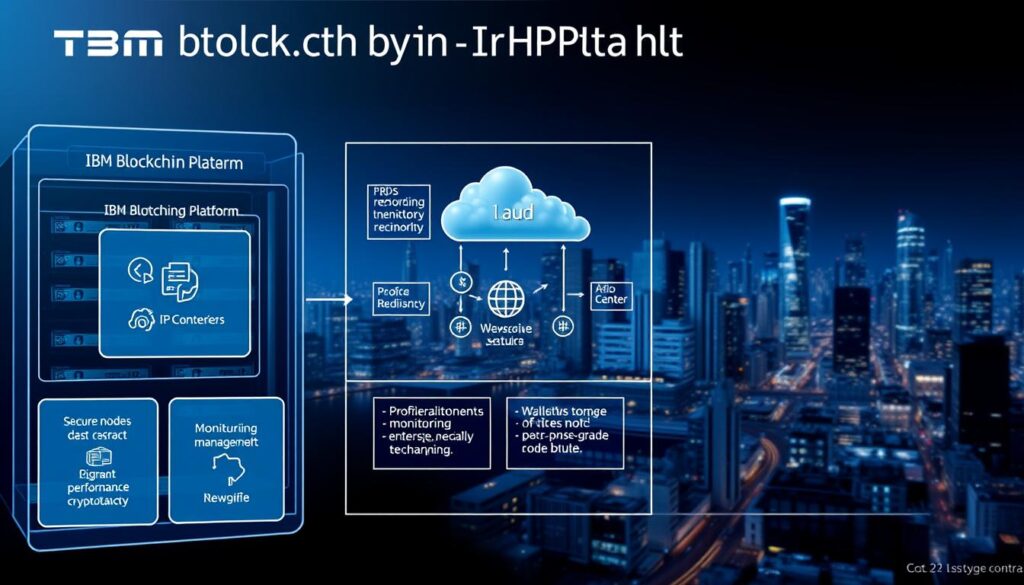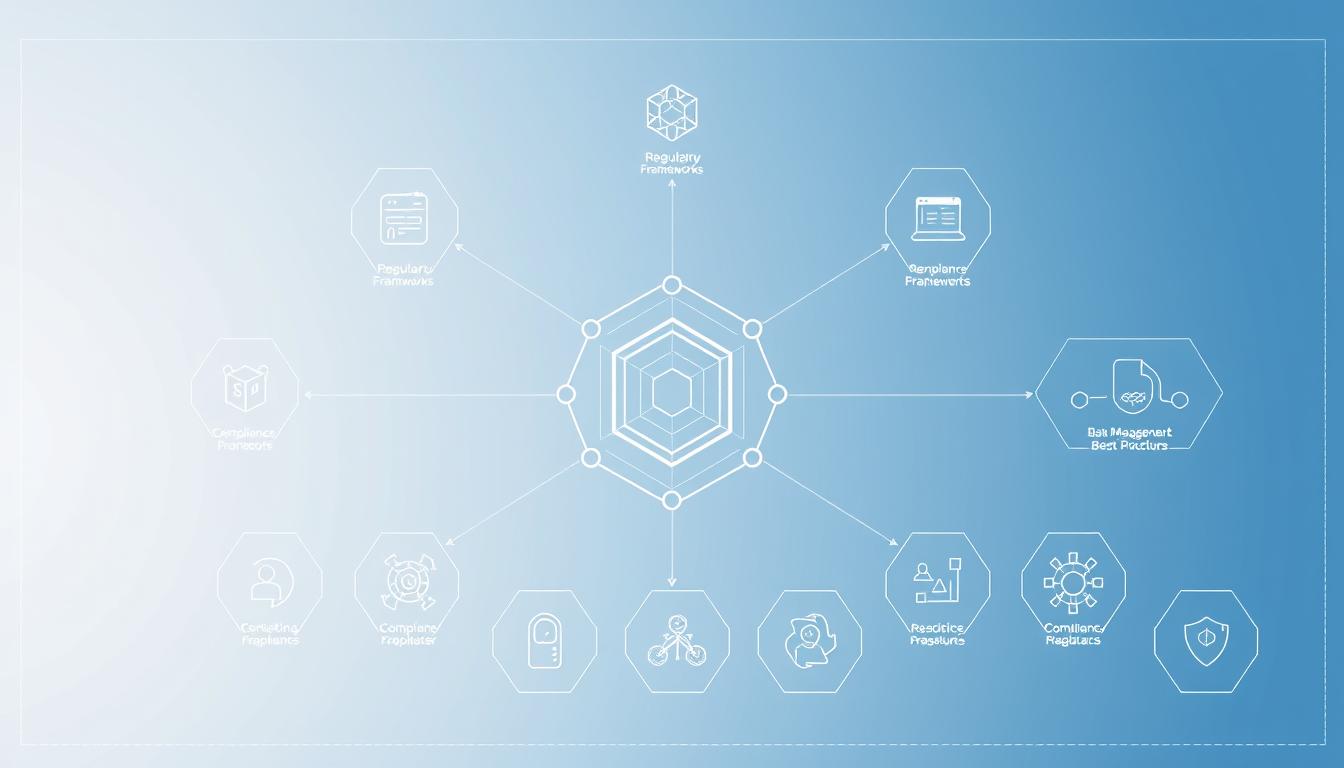Now Reading: Blockchain as a Service: Comparing Top Platforms
- 01
Blockchain as a Service: Comparing Top Platforms
Blockchain as a Service: Comparing Top Platforms

The demand for enterprise blockchain solutions is reshaping how businesses approach digital infrastructure. With 63% of Fortune 500 companies now exploring decentralized systems, managed cloud blockchain services have become critical for scaling operations securely. This shift allows organizations to focus on innovation rather than maintaining complex distributed networks in-house.
Leading BaaS providers now offer tools that simplify deployment across hybrid environments while meeting strict compliance standards. Our analysis focuses on four core evaluation metrics: security protocols, integration flexibility, cost efficiency, and cross-platform compatibility. These factors determine which solutions deliver real value for supply chain, finance, and data management use cases.
Recent market data reveals a 41% annual growth rate for managed ledger systems, driven by industries requiring audit-ready transaction records. Unlike traditional IT models, modern enterprise blockchain solutions prioritize interoperability with existing ERP and CRM platforms. This evolution makes selecting the right provider essential for long-term operational success.
Key Takeaways
- Managed decentralized systems reduce development costs by up to 65% compared to in-house builds
- Top evaluation factors include compliance certifications and API-driven architecture
- Cloud-based offerings now support multi-chain configurations for complex workflows
- Leading providers differentiate through industry-specific smart contract templates
- Integration with legacy systems remains a critical selection criterion
Understanding Blockchain as a Service Fundamentals
Blockchain as a Service (BaaS) provides the backbone for businesses adopting decentralized solutions without infrastructure headaches. This section explores the technical building blocks and deployment strategies that make BaaS platforms operational.
Core Components of BaaS Architecture
Effective BaaS platforms rely on two critical subsystems working in tandem:
Distributed Ledger Management Systems
These systems handle data storage across multiple nodes using advanced synchronization protocols. Key features include:
- Automated node provisioning for network expansion
- Dynamic consensus mechanisms (PoW, PoS, PBFT)
- Immutable transaction records with cryptographic hashing
Smart Contract Execution Environments
Secure sandboxes enable automated business logic enforcement through:
- Containerized runtime isolation
- Multi-language support (Solidity, Go, Java)
- Real-time monitoring dashboards
Typical BaaS Deployment Models
Enterprises choose configurations based on control needs and data sensitivity:
Public vs Private Chain Configurations
Public chains offer maximum transparency but limited privacy, while private chains provide restricted access with enhanced performance. Financial institutions often blend both approaches.
Hybrid Blockchain Solutions
These combine elements from multiple network types:
| Feature | Public Chain | Private Chain | Hybrid Chain |
|---|---|---|---|
| Access Control | Open | Permissioned | Selective |
| Transaction Speed | 5-15 TPS | 1,000+ TPS | 200-500 TPS |
| Use Cases | Crypto transactions | Supply chain tracking | Healthcare data sharing |
Hybrid chain deployment shines in scenarios requiring partial transparency, like cross-border trade documentation. Pharmaceutical companies use this model to share trial data securely while meeting regulatory audits.
Key Benefits of Enterprise Blockchain Adoption
Organizations adopting blockchain solutions report measurable improvements across operational and security metrics. This section examines concrete advantages driving enterprise adoption, supported by industry data and practical use cases.
Operational Efficiency Improvements
Blockchain technology streamlines complex business processes through decentralized automation. Leading enterprises achieve 40% faster transaction processing times compared to legacy systems.
Automated Reconciliation Processes
Smart contracts eliminate manual data matching in supply chain and financial operations. A 2023 Deloitte study found companies reduced reconciliation errors by 78% while cutting processing costs by $17 per transaction.
Real-Time Audit Capabilities
Permissioned ledgers enable instant verification of transaction histories across organizations. This transaction transparency reduces audit preparation time from weeks to hours in cross-border trade scenarios.
| Audit Process | Traditional Systems | Blockchain Solutions |
|---|---|---|
| Data Collection | 14-21 days | Real-time |
| Error Detection | Manual review | Automated alerts |
| Compliance Reporting | Quarterly | Continuous |
Enhanced Security Features
Blockchain’s architectural design provides inherent security advantages over centralized databases. Financial institutions using distributed ledgers report 94% fewer successful cyberattacks compared to traditional systems.
Cryptographic Data Protection
Advanced encryption standards (AES-256) and hash functions secure sensitive information at rest and in transit. Each transaction receives unique digital fingerprints that prevent unauthorized alterations.
Immutable Transaction Records
Once added to the chain, records become permanently timestamped and tamper-evident. This feature improves blockchain ROI by reducing fraud investigation costs by up to 65% in banking applications.
| Security Metric | Traditional Systems | Blockchain |
|---|---|---|
| Data Breach Risk | High | Low |
| Encryption Standard | 128-bit | 256-bit |
| Update Vulnerability | Central points | Distributed nodes |
Blockchain as a Service Platforms Comparison: Evaluation Framework
To navigate the complex BaaS landscape, organizations need a criteria-driven assessment model tailored to their industry requirements. This framework evaluates platforms through technical viability and business impact, using a weighted scoring system to prioritize factors critical to specific sectors like healthcare or logistics.
Technical Requirements Analysis
Effective BaaS evaluation starts with verifying platform architecture against operational needs. Two non-negotiable elements separate enterprise-ready solutions from basic offerings:
Consensus Mechanism Support
Leading platforms support multiple protocols like Proof-of-Authority (PoA) and Practical Byzantine Fault Tolerance (PBFT). Financial institutions often require Byzantine fault-tolerant systems, while supply chain networks might prioritize energy-efficient alternatives.
Interoperability Standards Compliance
Cross-platform compatibility proves essential for enterprises using hybrid systems. Look for solutions adhering to:
- Hyperledger Cactus integration patterns
- Enterprise Ethereum Alliance specifications
- ISO/TC 307 blockchain interoperability standards
Business Considerations
Technical capabilities mean little without financial sustainability and regulatory alignment. Decision-makers should balance these operational factors:
Total Cost of Ownership Models
Comprehensive TCO analysis accounts for:
- Infrastructure scaling costs
- Smart contract maintenance fees
- Cross-cloud transaction charges
Industry-Specific Certifications
Healthcare platforms require HIPAA compliance, while financial services demand SOC 2 Type II certifications. Leading providers now offer pre-configured compliance packages for major verticals.
| Evaluation Criteria | Manufacturing Weight | Retail Weight |
|---|---|---|
| Transaction Finality | 15% | 10% |
| Data Privacy | 20% | 25% |
| API Latency | 10% | 15% |
Amazon Managed Blockchain
Amazon Managed Blockchain simplifies enterprise blockchain deployment through deep AWS ecosystem integration. As a fully managed service, it eliminates infrastructure setup while offering native compatibility with 35+ AWS tools. Enterprises can launch blockchain networks in minutes rather than months, making it a top choice for companies prioritizing rapid deployment.

Platform Overview
The platform’s strength lies in its seamless connectivity with AWS services. Developers leverage Lambda functions for smart contract automation and S3 buckets for immutable ledger backups. This integration reduces custom coding by 40–60% compared to self-managed alternatives.
AWS Ecosystem Integration Capabilities
Key integration features include:
- Real-time data streaming to Amazon Kinesis
- AI-powered analytics via QuickSight
- Identity management through AWS IAM
These tools enable enterprises to build end-to-end blockchain solutions without leaving the AWS environment. For technical specifics, see our comprehensive guide.
Key Differentiators
Amazon’s blockchain service stands out through specialized infrastructure optimizations. Performance benchmarks show 2,100 transactions per second (TPS) for Hyperledger networks – 30% faster than industry averages.
Managed Hyperledger Fabric Nodes
The platform automates node provisioning and certificate management for Hyperledger Fabric hosting. Enterprises save 150+ engineering hours monthly through:
- Automatic security patches
- Dynamic scaling from 2 to 15 nodes
- Built-in monitoring via CloudWatch
Ethereum Mainnet Connectivity
Unique among major BaaS providers, Amazon enables direct Ethereum mainnet access. Developers can:
- Deploy hybrid public/private networks
- Access ETH historical data through Managed Blockchain APIs
- Integrate with MetaMask wallets
Implementation Considerations
While powerful, the platform requires careful cost planning. A 10-node Hyperledger network costs $4,100/month – 22% less than equivalent Azure deployments but 18% pricier than other leading blockchain platforms.
Pricing Structure Analysis
| Component | Cost | Usage Threshold |
|---|---|---|
| Hyperledger Node | $0.30/hour | First 2 nodes free |
| Ethereum Node | $0.50/hour | Mainnet fees apply |
| Data Storage | $0.023/GB | First 50 GB free |
Enterprise Deployment Case Studies
Fortune 500 adopters include:
- A healthcare consortium reducing drug counterfeit incidents by 76%
- An automotive supplier tracking 12M+ parts annually
- A financial institution settling $4B monthly transactions
Microsoft Azure Blockchain Service
Microsoft’s Azure Blockchain Service combines enterprise-grade infrastructure with adaptable tools, positioning itself as a leader in permissioned blockchain solutions. Its hybrid architecture bridges cloud efficiency with industry-specific customization, particularly through strategic partnerships like Kaleido. Let’s explore what makes this platform a top choice for complex organizational needs.
Architecture Overview
The platform’s backbone integrates Azure Active Directory for seamless identity management. This feature simplifies permission controls across distributed networks while maintaining compliance with enterprise security standards. Role-based access ensures only authorized participants can view or modify sensitive data layers.
Azure Active Directory Integration
By syncing with existing corporate directories, organizations reduce onboarding friction for consortium members. Multi-factor authentication and automated user provisioning create audit-ready environments ideal for regulated industries like finance and healthcare.
Notable Features
Azure’s blockchain toolkit stands out through its balance of performance and flexibility. The platform supports multiple ledger frameworks while prioritizing interoperability with legacy systems.
Proof-of-Authority Consensus
This energy-efficient protocol validates transactions through approved validators rather than computational power. Enterprises benefit from faster finality times—critical for supply chain tracking or real-time payment settlements.
Kaleido Partnership Advantages
Microsoft’s collaboration with Kaleido delivers pre-built templates for common use cases:
- Pharmaceutical supply chain monitoring
- Cross-border trade finance workflows
- Healthcare data exchange frameworks
These accelerators reduce development timelines by up to 40% compared to building from scratch.
Enterprise Adoption Patterns
Major corporations leverage Azure’s blockchain to solve specific operational challenges while maintaining scalability. The platform’s modular design supports gradual expansion from pilot projects to full production networks.
Supply Chain Implementations
Retail giants use Azure to track goods from raw materials to store shelves. A recent automotive consortium achieved 92% faster defect tracing by implementing blockchain-based parts authentication across 17 manufacturing sites.
Cross-Industry Consortium Support
Azure powers collaborative networks where competitors share infrastructure securely:
| Industry | Use Case | Participants |
|---|---|---|
| Banking | Loan syndication | 12 global banks |
| Energy | Carbon credit trading | 8 utility providers |
| Insurance | Claims processing | 5 multinational firms |
These enterprise consortiums demonstrate how Azure facilitates trustless collaboration at scale while maintaining data sovereignty.
IBM Blockchain Platform
IBM’s blockchain solutions stand out for their deep integration with enterprise IT ecosystems and regulated industry requirements. The platform combines flexible architecture with compliance-first design, making it a top choice for financial institutions and global supply chain operators.

Technical Architecture
At its core, IBM Blockchain Platform leverages Red Hat OpenShift to create containerized environments. This integration allows businesses to deploy blockchain networks across hybrid cloud setups while maintaining existing Kubernetes workflows.
Red Hat OpenShift Integration
OpenShift’s orchestration tools simplify consortium blockchain management for multi-organization partnerships. Teams can automate node deployments, apply security patches, and monitor network health through a unified dashboard.
Enterprise-Grade Features
IBM prioritizes security and compliance through advanced cryptographic protections and audit frameworks. These features address strict requirements in sectors like banking and pharmaceuticals.
HSM-Backed Key Management
The platform uses Hardware Security Modules (HSMs) for enterprise key management, ensuring private keys never expose to network vulnerabilities. This approach meets FIPS 140-2 standards for financial transactions.
Regulatory Compliance Tools
Built-in templates help organizations align with GDPR, HIPAA, and Basel III regulations. Automated reporting tools generate audit trails for cross-border trade documentation and product provenance records.
Industry Solutions
IBM tailors its blockchain offerings to solve specific sector challenges, from food safety verification to trade finance automation.
Food Trust Network Implementations
The IBM Food Trust network tracks over 30,000 food products globally, reducing recall investigation times by 98%. Retailers like Walmart use it to verify produce origins in seconds instead of days.
Trade Finance Applications
Banks leverage IBM’s blockchain to process letters of credit 80% faster. Smart contracts automatically validate shipping documents against payment terms, cutting disputes by 65% in pilot programs.
Oracle Blockchain Platform
Oracle’s blockchain solution stands out for its enterprise-grade adaptability, combining robust technical architecture with deep business application integration. Designed for organizations needing seamless alignment between distributed ledger technology and existing IT ecosystems, the platform excels at bridging operational silos while maintaining compliance standards.
Technical Specifications
The platform leverages Oracle Cloud Infrastructure (OCI) for optimized performance, offering:
- Pre-built smart contract templates for common business logic
- Dynamic scaling from 10 to 10,000+ transactions per second
- Native integration with OCI’s AI/ML services for predictive analytics
Oracle Cloud Infrastructure Integration
Deep OCI compatibility enables automatic resource allocation during transaction spikes. Enterprises benefit from unified monitoring through Oracle’s cloud management dashboard, which provides real-time insights comparable to AWS and Azure solutions.
Business Process Integration
Oracle’s platform shines in connecting blockchain networks with core enterprise systems through:
ERP System Connectivity
Pre-configured adapters enable bidirectional data flow between blockchain nodes and Oracle ERP modules. Financial reconciliation processes accelerate by 40-60% through automated ledger matching.
Legacy System Adaptation Tools
The platform’s legacy integration toolkit includes:
- API gateways with SAML/OAuth support
- Batch data migration utilities
- Visual workflow mapping interface
Use Case Examples
Real-world implementations demonstrate Oracle’s industry-specific value:
Pharmaceutical Supply Chain Tracking
Major drug manufacturers use the platform to:
| Process | Traditional Approach | Blockchain Solution |
|---|---|---|
| Batch Verification | 7-10 business days | 22 minutes average |
| Recall Management | Partial traceability | End-to-end visibility |
| Regulatory Reporting | Manual aggregation | Automated audit trails |
Document Notarization Workflows
Legal departments achieve 80% faster contract execution through:
- Automated timestamping with cryptographic proofs
- Multi-party digital signature workflows
- Immutable version control history
Alibaba Cloud Blockchain as a Service
As global enterprises seek localized blockchain solutions, Alibaba Cloud’s BaaS platform stands out with its Asia-centric infrastructure and regulatory alignment. Designed to meet the complex demands of cross-border commerce, this service combines technical innovation with deep regional expertise.

Regional Infrastructure Advantages
Alibaba’s dominance in the APAC market stems from its strategically distributed data centers across key economic hubs. With 82 availability zones in 27 regions, businesses gain low-latency access to blockchain networks while maintaining data sovereignty.
Asia-Pacific Data Center Network
- Direct integration with China’s Golden Tax System for automated compliance
- Dedicated nodes in Singapore, Malaysia, and Indonesia for trade finance operations
- Private blockchain channels for cross-border data transfers
Specialized Features
The platform excels in addressing region-specific challenges through tailored modules. Financial institutions benefit from pre-built tools that streamline complex regulatory processes.
Anti-Money Laundering Modules
Automated transaction monitoring systems align with China’s PBOC regulations, featuring:
- Real-time identity verification via national ID databases
- AI-powered risk scoring for suspicious activities
Cross-Border Trade Solutions
Alibaba’s trade finance BaaS reduces documentary processing time by 68% through:
- Smart contract templates for Letters of Credit
- Integrated customs clearance APIs
- Multi-currency settlement workflows
Implementation Considerations
While Alibaba’s platform offers robust capabilities, successful deployment requires understanding local operational realities.
Multi-Language SDK Support
Developers can access toolkits in 12 languages, including Mandarin, Bahasa, and English, enabling:
- Faster integration with regional payment gateways
- Simplified smart contract deployment
Local Compliance Requirements
Enterprises must navigate China’s Cybersecurity Law and Data Localization Mandates:
| Requirement | Alibaba Solution |
|---|---|
| Data residency | Onshore blockchain nodes |
| Audit trails | Immutable logs with government access protocols |
| KYC verification | Integrated with National Enterprise Credit System |
SAP Cloud Platform Blockchain
SAP’s blockchain solution stands out for its deep enterprise resource planning integration and industry-focused applications. The platform combines distributed ledger technology with SAP’s ERP ecosystem, creating tailored solutions for complex supply chain and manufacturing challenges.
Seamless ERP Connectivity
The platform’s SAP S/4HANA connectivity enables real-time data synchronization between blockchain networks and core business systems. This integration allows companies to:
- Automate smart contract execution through purchase orders
- Track material movements across global suppliers
- Verify compliance documentation instantly
A major aerospace manufacturer reduced part certification time by 68% using this integration, linking IoT sensors on aircraft components directly to their SAP ERP.
Tailored Industry Solutions
SAP delivers specialized blockchain tools addressing sector-specific pain points:
Manufacturing Material Tracking
Automotive suppliers use SAP’s solution to trace rare-earth metals from mine to assembly line. IoT-enabled containers update blockchain records at each transit point, reducing counterfeit part risks by 92% in pilot programs.
Aviation Parts Provenance
The platform’s aviation blockchain module creates immutable maintenance histories for aircraft components. One airline maintenance network cut audit preparation time from 14 days to 6 hours using this feature.
Flexible Deployment Options
SAP supports multiple implementation strategies to meet diverse enterprise needs:
Cloud vs On-Premise
| Feature | Cloud | On-Premise |
|---|---|---|
| Deployment Speed | 2-4 days | 4-6 weeks |
| Maintenance | SAP-managed | In-house IT |
| Customization | Standard modules | Full control |
Multi-Cloud Support
The platform operates across AWS, Azure, and Google Cloud, enabling hybrid deployments. A pharmaceutical company recently used this feature to maintain EU data residency rules while using US-based blockchain nodes.
Huawei Blockchain Service
Huawei’s blockchain platform combines global infrastructure with military-grade security, offering unique solutions for enterprises needing high transaction throughput. The service supports 10,000+ transactions per second while maintaining energy efficiency – a critical advantage for organizations scaling blockchain operations.
Global Infrastructure Network
Huawei operates 23 availability zones across six continents, enabling businesses to deploy blockchain nodes closer to end-users. This geographical spread reduces latency for international transactions while complying with regional data laws.
Multi-region deployment options
- Automatic node synchronization between Frankfurt and Singapore hubs
- Hybrid cloud configurations for sensitive government workloads
- Disaster recovery clusters with sub-30-second failover capabilities
Technical Capabilities
The platform’s architecture uses proprietary innovations to address common blockchain limitations. Recent stress tests showed 98% throughput consistency during peak demand periods.
High-performance consensus algorithms
| Algorithm | Transactions/Second | Energy Use |
|---|---|---|
| Huawei BFT | 12,000 | 0.8 kWh |
| Practical Byzantine | 3,000 | 2.1 kWh |
| Proof-of-Authority | 5,400 | 1.4 kWh |
Confidential computing features
Huawei’s secure enclave technology protects sensitive data during processing. Government agencies use this for:
- Encrypted voter registration systems
- Tax record anonymization
- Classified document timestamping
Enterprise Adoption Trends
Over 140 government agencies worldwide use Huawei’s blockchain for public service automation. The platform processes $4.7 billion in daily cross-border payments through partner banks.
Government sector implementations
Shenzhen’s smart city project reduced permit approval times by 68% using Huawei’s blockchain. Key features driving adoption:
- Real-time audit trails for compliance
- Inter-departmental data sharing protocols
- AI-powered fraud detection modules
Cross-border payment solutions
Commercial banks achieve 2-second settlement times for international transfers using Huawei’s network. The system supports 47 currencies and complies with FATF travel rule requirements.
Emerging BaaS Contenders
While established players dominate enterprise blockchain adoption, innovative platforms are carving niches with specialized architectures. These emerging BaaS providers target specific industries and technical requirements, offering alternatives to mainstream solutions.
VMware Blockchain
Byzantine Fault Tolerance Consensus
VMware’s enterprise-grade platform uses BFT consensus to achieve fast transaction finality in permissioned networks. Its modified SBFT (Scalable Byzantine Fault Tolerance) algorithm supports:
- Sub-second transaction confirmation
- Linear scalability across nodes
- Energy-efficient validation process
The architecture excels in supply chain applications where multiple stakeholders require equal validation rights without centralized control.
R3 Corda Enterprise
Financial Services Specialization
Designed explicitly for banking institutions, R3’s Corda enterprise solutions provide:
- Interbank transaction privacy layers
- Regulatory compliance templates
- Atomic settlement workflows
Over 300 financial institutions use Corda for cross-border payments and trade finance, leveraging its unique notary architecture for transaction validation.
Chainstack Business Protocol
Multi-Protocol Support Analysis
This Singapore-based contender supports 15+ blockchain protocols through unified APIs. Key advantages include:
- Simultaneous Ethereum/Hyperledger deployments
- Automated protocol switching
- Cross-chain monitoring dashboards
Chainstack reduces vendor lock-in risks for enterprises testing multiple distributed ledger technologies.
| Platform | Key Feature | Industry Focus | Consensus Mechanism |
|---|---|---|---|
| VMware Blockchain | BFT consensus | Multi-industry | Scalable BFT |
| R3 Corda Enterprise | Financial workflows | Banking | Pluggable consensus |
| Chainstack | Multi-protocol | Tech enterprises | Protocol-dependent |
These platforms demonstrate how BFT consensus mechanisms and industry-specific designs are shaping next-generation BaaS offerings. Enterprises should evaluate them against their need for specialization versus general-purpose functionality.
Strategic Selection Methodology
Selecting the optimal blockchain-as-a-service platform demands a systematic framework that aligns technical needs with business goals. Organizations must balance innovation with risk mitigation while ensuring scalability for future growth.
Implementation Roadmap Development
Successful BaaS adoption begins with phased execution. Establish clear milestones while maintaining flexibility for market changes or technical hurdles.
Proof-of-concept planning
Validate platform capabilities through targeted testing:
- Define success metrics for transaction speed and data integrity
- Allocate resources for 6-8 week testing cycles
- Create failure scenarios to assess error handling
Migration strategy formulation
Transition existing systems without disrupting operations:
- Conduct legacy infrastructure audit
- Prioritize data migration sequences
- Implement parallel run periods for system validation
Vendor Evaluation Checklist
Assess providers using quantifiable metrics that reflect enterprise priorities. Focus on contractual protections and operational resilience.
Service level agreement components
Critical SLA benchmarks should include:
- 99.95% minimum uptime guarantees
- Response time thresholds for security incidents
- Penalty structures for missed commitments
Disaster recovery requirements
Ensure continuity through:
- Geographically distributed node architecture
- Automated failover mechanisms
- Quarterly recovery drill mandates
| Evaluation Criteria | Weight | Measurement |
|---|---|---|
| Compliance Coverage | 20% | Certifications per industry standard |
| Performance SLAs | 25% | Transaction throughput metrics |
| Recovery Time Objectives | 15% | Maximum downtime allowances |
| Scalability Limits | 30% | Node expansion capabilities |
Evolution of Enterprise Blockchain Solutions
Enterprise blockchain solutions continue advancing as emerging technologies reshape the BaaS landscape. Quantum-resistant cryptography now tops development roadmaps for platforms like IBM Blockchain and Microsoft Azure, addressing vulnerabilities in traditional encryption methods. Leading providers prioritize integration with post-quantum algorithms to future-proof decentralized networks against next-generation computing threats.
Artificial intelligence merges with blockchain technology trends through automated smart contract optimization and predictive analytics. SAP Cloud Platform Blockchain demonstrates this synergy by embedding machine learning directly into supply chain workflows. Such integrations enable real-time decision-making while maintaining immutable audit trails across partner ecosystems.
Regulatory frameworks increasingly influence the future of BaaS as governments establish digital asset guidelines. Platforms like R3 Corda Enterprise now offer modular compliance features adaptable to evolving FATF standards and regional data laws. This flexibility proves critical for multinational corporations managing cross-border transactions under conflicting jurisdictions.
Interoperability emerges as a decisive factor in blockchain technology trends, with Alibaba Cloud and Chainstack developing universal protocol translators. These tools enable seamless communication between Hyperledger Fabric networks and public chains like Ethereum – a crucial capability for enterprises scaling decentralized applications.
The future of BaaS hinges on balancing innovation with enterprise-grade reliability. As platforms incorporate zero-knowledge proofs and decentralized identity management, businesses must evaluate providers through both technical and strategic lenses. Decision-makers should prioritize vendors demonstrating active R&D investments aligned with their industry’s digital transformation timeline.














